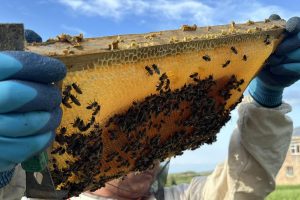The synthetic rubber plant “Nairit” was opened in 1936 nearby Yerevan. It supplied 34 kinds of chemical products to the Soviet Union and Soviet-bloc countries in its most prolific years. “Nairit” was the engine of the Soviet Armenia’s economy and industry providing jobs for thousands of people and 40% of the country’s income. However, the ecological movement that sparked national change in 1988 ended Nairit’s 50-year-long uninterrupted productivity. Members of the environmental movement demanded an end to the production of chloroprene rubber which is poisonous for the environment. They sought a new specialization for the plant, saying everything it produced should be safe. Then, no one could imagine that the plant would become a “curse” for the economy of independent Armenia. From that moment to today, the plant has been cited in scandalous financial and political deals and is in liquidation.
The Situation
“Nairit” is only 7km far from the Republic Square in Yerevan. It is known to be bankrupt,and is not operating as a plant anymore. It occupies an area of more than 160 hectares in the capital. For comparison, one of the central and largest public parks in London, Hyde Park, occupies 142 hectares and is one of the Royal Parks in London, founded 480 years ago.
“Nairit Plant”, which first opened 80 years ago, has never come close to being Hyde Park, though its site is about 20% of the common use green area of Yerevan. There are currently about 10 types of toxic substances at the factory—it threatens to become the main repository for industrial waste in Yerevan and poses the threat of ecological disaster to the citizens.
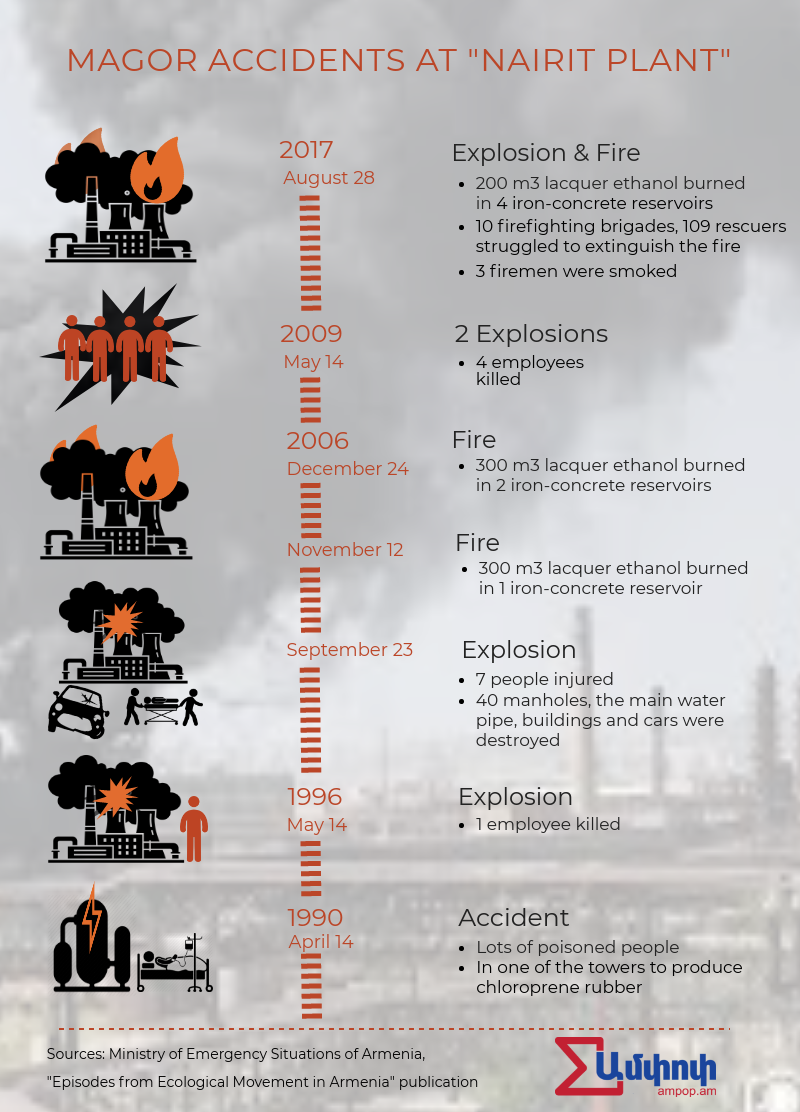 The last accident was on August 28, 2017. That was an explosion followed by a fire at the plant’s lacquer ethanol storage. Four iron-concrete containers filled with ethanol were burning for hours. Citizens of the capital will long remember thick and black smoke which emitted from the plant, visible from almost every district of the city. Lacquer ethanol is one of the waste substances from the plant. In case of high temperature, it can be self-ignited. This substance must be kept away from the direct rays of the sun, in a closed area where the temperature should not exceed 30 degrees. The warranty period of storage for it is one year from the date of manufacture. Fires also broke out in 2006 and 2009, due to the ignition of lacquer ethanol.
The last accident was on August 28, 2017. That was an explosion followed by a fire at the plant’s lacquer ethanol storage. Four iron-concrete containers filled with ethanol were burning for hours. Citizens of the capital will long remember thick and black smoke which emitted from the plant, visible from almost every district of the city. Lacquer ethanol is one of the waste substances from the plant. In case of high temperature, it can be self-ignited. This substance must be kept away from the direct rays of the sun, in a closed area where the temperature should not exceed 30 degrees. The warranty period of storage for it is one year from the date of manufacture. Fires also broke out in 2006 and 2009, due to the ignition of lacquer ethanol.
According to the Ministry of Emergency Situations, today this substance, with an amount of 1,223 tons, is the biggest threat in the factory.
From time to time, former employees of the plant remind the Government of the existence of “Nairit” or, more precisely, the necessity of reopening it. They also mention their unpaid salaries.
Although the Armenian government assures them wages were fully paid, it does not mention anything about the fate of the plant. There is no any reference to the “Nairit Plant” in the government’s reform program for 2017-2022.
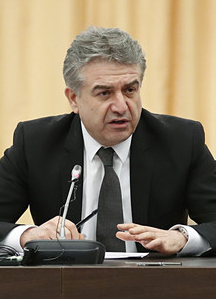
The RA Prime Minister Karen Karapetyan: We must get rid of illusions and sit down with a pen and paper to look into the situation. The government made three or four attempts to attract investors for the plant, which is very costly to the budget. To make another attempt, to spend money on something which may have no future is quite risky now. But if there are investors with all the factors and risks accounted then … however, I do not recall a potential investor requesting energy prices from our country. If you do not ask for energy prices but you go into the business, then there is a problem. Don’t you agree?
An extract from the “Q&A” session with the Government in the National Assembly October 14, 2016
Interestingly, on February 23, 2018, a week after this research article was published, a limited liability company, called A-S INVESTMENTS, sent the Prime Minister a letter asking for a property acquisition of Nairit-2 and received the Government’s positive response. And during March 1 session the government made a decision to sell a part of Nairit-2 Chemical Plant’s assets located on 10.3 hectares to A-S INVESTMENTS Company for the price of 627 million AMD. By the way, A-S INVESTMENTS, according to the State Register Agency of Legal Entities of the Republic of Armenia, was established on February 22, the day before submitting the application to the Prime Minister.
Production Of “Nairit”

Chloroprene rubber was the main one of 34 types of chemical products manufactured at the factory. This is an elastic, light yellowish material with a number of valuable properties: high mechanical strength, oil and light resistant.
Due to these properties, this material is widely used in the production of key industrial items – conveyors, power conductors and insulators, pipes, wire and cable protective coatings. Some of the by-products of the plant were caustic soda, quicklime (partly used for domestic needs), hydrogen (used as fuel for domestic needs), sodium hypochlorite (bleach) and more.
Liquidation
According to the World Bank’s report on the plant operation as of June 2015, re-launching of “Nairit Plant” is inappropriate as the possible cost of the plant’s production is estimated to exceed the forecast market price of chloroprene rubber this making the plant production uncompetitive and pricing it out of the market.
The report also says the plant resumption would require a trade policy to protect domestic market and a capital investment in the range of $ 210-346 million, almost as much as the plant had debts. Hence, the report concludes that these technical and financial considerations suggest that the Government should consider developing and implementing a liquidation plan.
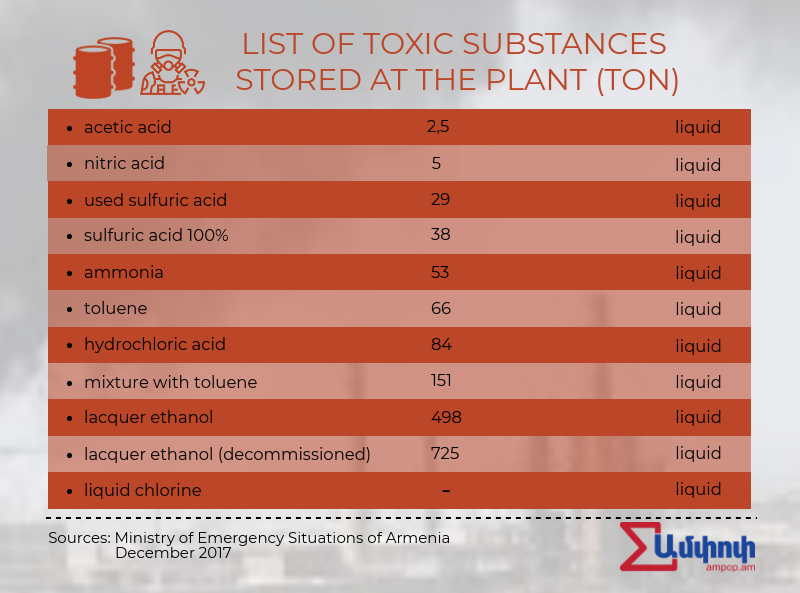
Whether the Government undertook the plant liquidation guided by the WB assessment, it seemed to inspire confidence to start the process. In the first half of 2016, eight months after the WB report, all of the “Nairit Plant” employees, including the management, received notices on a dismissal. However, previously it was announced that at least 460 employees would keep on working to ensure the safety of the plant.
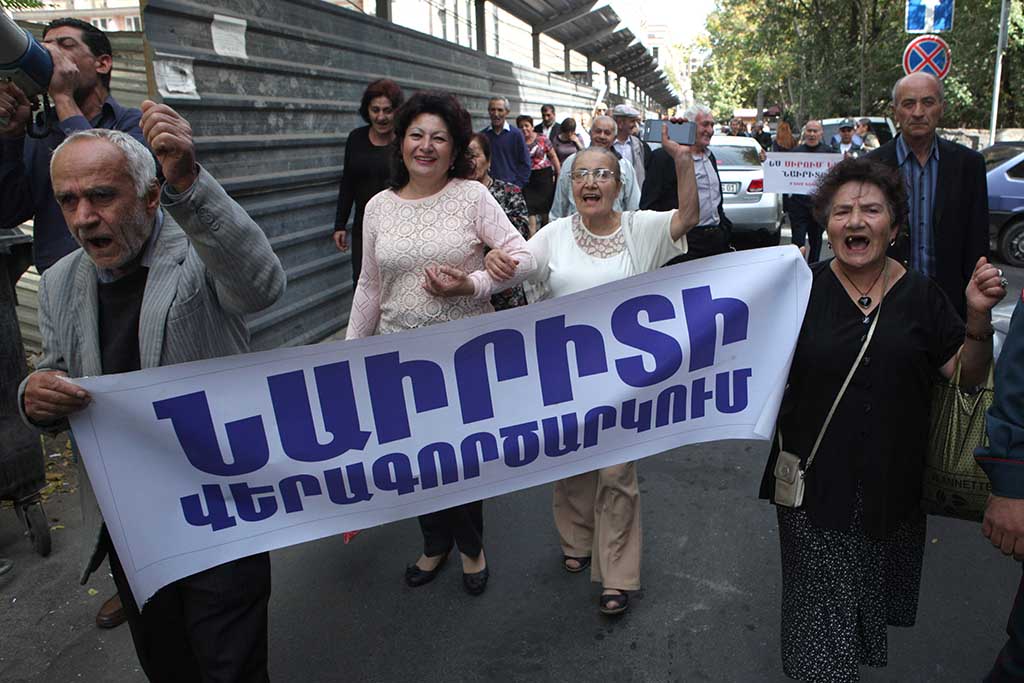
On November 28, 2016, the Court of Yerevan’s Shengavit district satisfied the claim of “Electric Networks of Armenia” to recognize Nairit Plant as bankrupt because of the electricity debt totaling more than AMD 1 billion 235 million and AMD 160 million fines.
Three months after this decision, on February 17, 2017 the same court made two other decisions: to start liquidation proceedings of the company and instruct the bankruptcy manager to block the property and finances belonging to it in the manner prescribed by of the RA Law on Bankruptcy, Article 71, and to suspend activities as well as all the rights of management and property disposal of the debtor company. The official website of the factory, Nairit.am, which contains important data and reports on the plant, was not available for a long time, although the plant administration had paid for the domain until December 2018.
Worldwide Chloroprene Rubber Manufacturers
Japan is the dominant producer of polychloroprene rubber globally. Japanese producers account for 59% of the global market for this product. In the period 2006-2013, the Japanese producers increased the capacity by 80,000 tons/year, Chinese manufacturers – by 40,000 tons/year. The only North American producer has exited polychloroprene rubber production. Here there has been only one producer, DuPont Dow Elastomers. It shut down one of its two facilities and sold the other to the Japanese Denka joint venture (Denka 70%, Mitsui 30%). Germany is the only manufacturer in Western Europe. The German company, Lanxess, has about 83,000 tons/year of capacity. It produces both solid rubber and latex. The other chloroprene rubber production plant in Western Europe was in France, which had a capacity of 43,000 tons/year owned by Enichem. However, due to poor economic conditions and other issues, the older Enichem plant was closed down in 2005, and now Laxness is the sole producer of the product in Western Europe.
The price for polychloroprene rubber in the international market is $ 3000-5000 per ton.
According to calculations, the world capacity will remain unchanged (405 kilo/year), but will meet the global demand at least by 2025. In 2018, the demand will be 361 kilotons.
The Background
Nairit accounted for 3% of the global capacity polychloroprene rubber before discontinuation of production in 2010. In 1987, Nairit met 15% of the global demand.
The decision to stop Nairit’s production was made on June 25, 1989 by the Supreme Council of Soviet Armenia. This was annulled after two years, on April 17, 1991 by the elite of the Armenian National Movement (ANM), one of the pioneers fighting for the stop of the plant. Henceforth, the Supreme Council of the Republic of Armenia adopted a new decision – to reopen the plant. Аnd it was re-launched in 1991-1992.
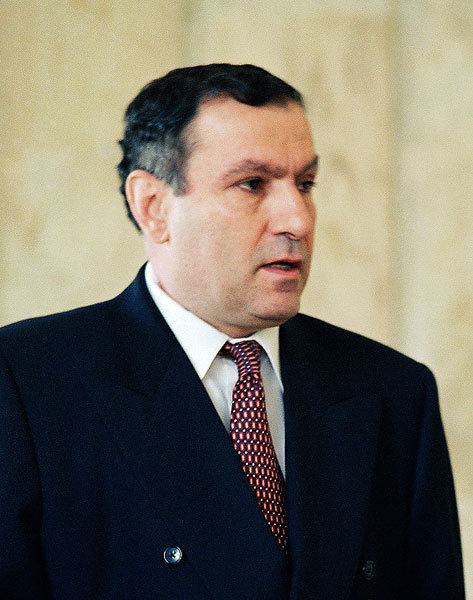
First Armenian President Levon Ter-Petrosyan: On my behalf, I can say that then I did not feel deeply the ecological expediency. For me, political considerations were the foremost. … We, the Armenian National Movement and the “Karabakh” Committee, were guided by political considerations. There was a political consideration. One of the considerations was that Nairit was not actually owned by us. We received toxicants from Nairit and worthless banknotes – 178 million rubles. This was all we received from Nairit. The rest of that huge wealth was managed by the Soviet Union.
NA archive, an extract from the speech on April 17, 1991
According to various sources, for the second time, the plant stopped functioning because of the financial crisis in 2008-2010, as well as by the private owner’s abandonment of the plant. As a result, more than half of the 2500 employees remained unemployed, while others waiting for their unpaid wages.
And due to consistent rallies and sit-down strikes at the government building and presidential office, in August 2015 the government paid the employees 18-24-month salaries amounting to $ 12 million.
However, the salary was only a small part of the plant’s loan. According to various estimates, the plant had accumulated debts totaling $ 300-500 million over 2006-2011, which resulted in a suit by the CIS Interstate Bank at the end of December 2011, claiming 90% of the Nairit Plant’s shareholder, Rhinoville Property Limited demanding penalties and fines for not paying off its debts. This was the same as to sue Nairit Plant, as Nairit had become a shareholder of Rhinoville Property.
Failing to pay, the plant became the property of the bank in 2012. According to RA Minister of Energy and Natural Resources Yervand Zakharyan, after long negotiations, in December 2015, Nairit was returned to the Armenian government.
Тhe scandalous stories on owners of Nairit refer also offshore transactions with the engagement of factory directors and high rank state officials. Similar stories can be accessed on Hetq online publication. (Find hyperlinks to these stories below, in “The reference shelf” section.)
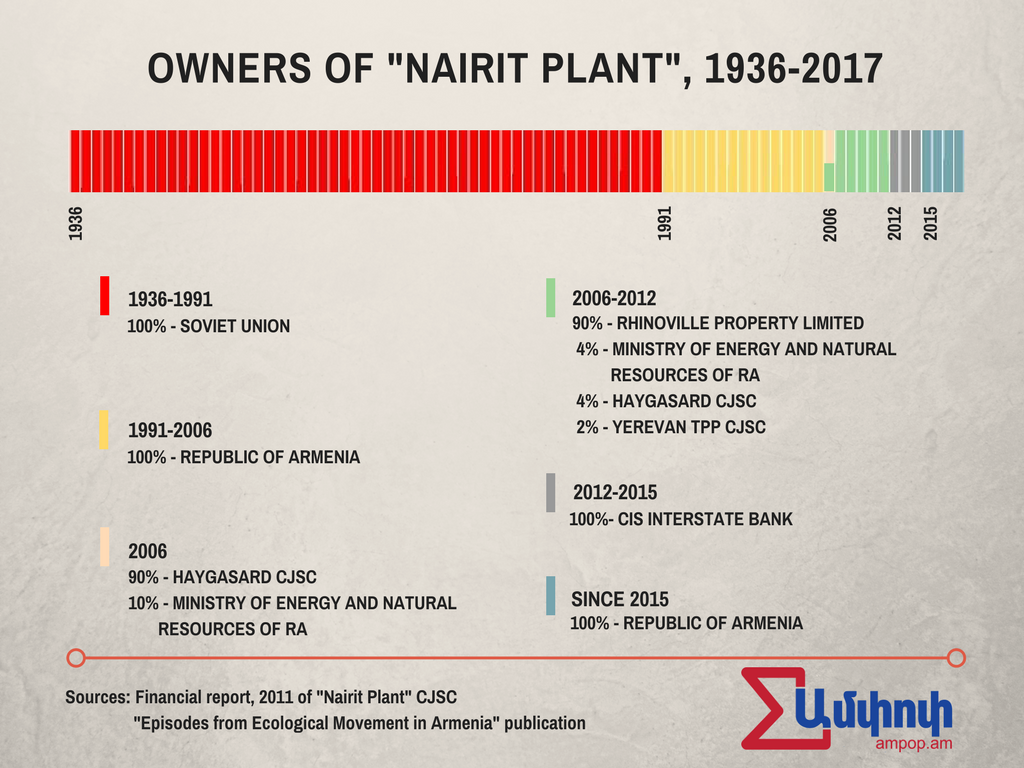
In Addition
In 2010, through the contribution of Nairit’s intellectual resources and certain equipment of the third production line the launching of the Armenian-Chinese company “Shanxi-Nairit” took place in China. A 40-percent stake in Shanxi-Nairit, according to the Ministry of Energy, holds Nairit Plant. Due to this bargain, the plant was expected to yield an estimated $10 million to Armenia’s state budget annually. Meanwhile, in response to Ampop Media’s request, the Ministry of Energy answered that the company has not worked with its full capacity in the period between 2010 and 2016, that is why his activity was at a loss and no dividends were paid to shareholders.
By the way, the Armenian-Chinese joint venture company is the third on the list of top rubber producers.
Text and infographics by Karine Darbinyan
Responsible editor: Suren Deheryan
The Reference Shelf
- Assessment of technical feasibility and financial viability of Nairit Factory, World Bank, 2015 June
- Hetq’s reference: 1) Nairit Loan Scam…, 2) Yet another scandalous revelation…
Փորձագետի կարծիք
First Published: 11/04/2018







